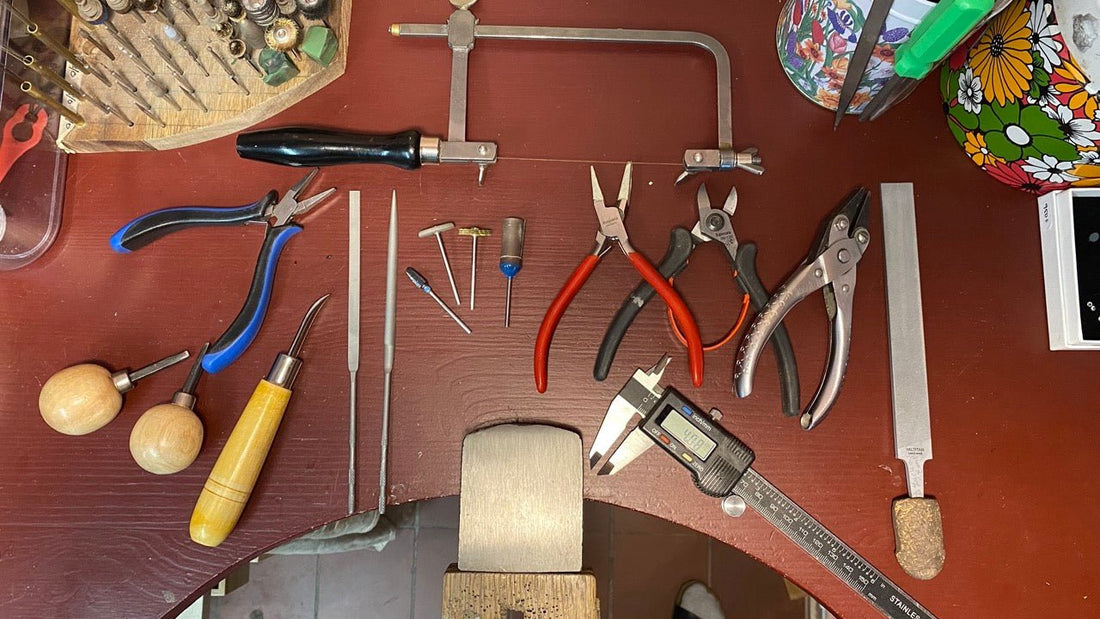
My best hand tools as a goldsmith and silversmith
Share
Working as a goldsmith and silversmith involves using a variety of tools to shape and process metal. In addition to accessories such as gas torches, pickling baths and rollers, there are many smaller hand tools that are invaluable for the work. If you are curious about blacksmithing and want to try it yourself, it might be good to know some of the tools that I use daily. Here I share my favorites and their uses.
I also have a guide to files, grinding and saw blades in jewelry making where I describe different sizes of saw blades, different cuts on files, etc.
Jewel saw

To cut metal you need a saw stand and saw blade. With it it is possible to saw sheet metal, wire and pipe with precision. The saw stand can be tensioned and adjusted to keep the saw blade taut, which is crucial for a good result. I usually use a saw blade in size 2/0, which works for many different types of work.
Approach file

Investing in a good file is important. I use a titanium file because it lasts longer than a traditional steel file. My favorite is the medium size and has a grit of 0, which makes it perfect for shaping and removing material efficiently.
Needle file

For more precision work, smaller files are a must. The ones I use the most are a flat file and a half-round file. These help create details and fine-tune the shape of the piece. I would recommend having some files in grit 0, and some in grit 6. So either coarse, or very fine.
Micromotor

A micromotor is a fantastic tool that allows you to drill, mill and grind with high precision. I recommend a micromotor with a foot pedal so you can easily adjust the speed while you work.
Grinding and milling tools for micromotor

With the right sanding and milling tools, you can achieve a variety of effects. Some of my favorites are:
- File cutter: Perfect for quickly removing material and creating a basic shape.
- Emery roller (grit 600): Used to smooth surfaces.
- Habrastrissa: Excellent for grinding and polishing cast objects without changing the shape.
- Rubber polisher with pumice stone: A real game changer for jewelry with set stones, as it doesn't grind the stones, only the metal. Perfect for working close to settings without risk of damage.
Fattarklove

A barrel clamp is used to hold the object while filing, grinding or setting stones. It provides a stable grip and makes the work more controlled and precise.
Socket pusher

A setting press allows you to secure a stone in its setting by gently pressing the metal over the edges of the stone. They are especially good for rim and claw settings. I have made my own from old punches that I have filed and sawed to a rounded shape, which reduces the risk of scratching the stone and setting.
Polishing steel

A burnishing steel is used to polish, harden and forge metal. By pressing it against the edge of a frame, for example, you get a hard and shiny surface, which gives a nice finish. If you have small pores in a cast object, you can also use the burnishing steel to compress the material and hide irregularities.
Cutting and shaping pliers

Pliers are indispensable tools when working with metal. They are used to cut, shape and hold small parts, making them essential in many aspects of jewelry making. Here are some of the ones I use the most:
- Wire cutters: When you are working with metal wire or distributing solder, you can easily snip it using wire cutters.
- Flat nose pliers: Perfect for shaping and adjusting loops.
- Parallel pliers: Provides even pressure and is good when you want to hold a detail without damaging it.
- Forming pliers: Has a semi-round and a flat side, making it ideal for shaping rings and bracelets, for example.
Digital caliper

A digital caliper is used to measure, for example, the thickness of sheets, the diameter of metal wires and the inner or outer dimensions of silver rings with very high precision. Unlike analog calipers, a digital version provides a fast and clear reading, which reduces the risk of incorrect measurements.
Planer hammer

A planer hammer is used to forge, harden, and create texture on metal. It has a round and a flat side, making it versatile for different types of work.
Summary
Whether you are a beginner or an experienced blacksmith, the right tools are crucial to a successful outcome. By investing in quality tools and understanding how to use them, you can create beautiful and durable jewelry. Hopefully this guide has given you inspiration and knowledge about which tools might be good to have in your own workshop!
2 comments
Jag köper pimpstens skivor och tillbehör hos nsg webbshop, finns också hos aktivt guld! Jag använder först en medelskiva sedan en fin. https://shop.nsg.se/sv/shop-b2b/p/235-pimpstensskiva-fin-12-mm
Hej, var köper du gummipolerare med pimpsten?
Mvh Anna-Karin Frejd